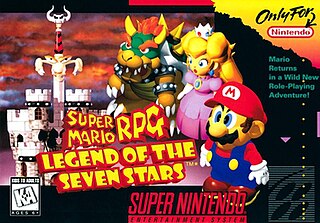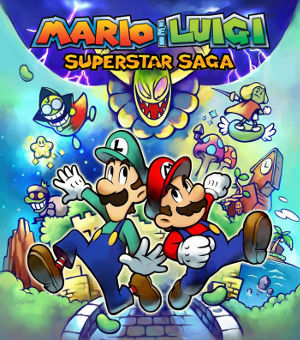
Super Mario Kart is a kart racing game developed and published by Nintendo for the Super Nintendo Entertainment System (SNES). The first game in the Mario Kart series, it was released in Japan and North America in 1992, and in Europe the following year in 1993. Selling 8.76 million copies worldwide, the game went on to become the fourth best-selling SNES game of all time. Super Mario Kart was re-released on the Wii's Virtual Console in 2009, on the Wii U's Virtual Console in 2013, and on the New Nintendo 3DS's Virtual Console in 2016. Nintendo re-released Super Mario Kart in 2017 as part of the company's Super NES Classic Edition.

Super Mario Bros. 3 is a 1988 platform game developed and published by Nintendo for the Nintendo Entertainment System (NES). It was released for home consoles in Japan on October 23, 1988, in North America on February 12, 1990 and in Europe on August 29, 1991. It was developed by Nintendo Entertainment Analysis and Development, led by Shigeru Miyamoto and Takashi Tezuka.

Super Mario World, known in Japan as Super Mario World: Super Mario Bros. 4, is a 1990 platform game developed by Nintendo EAD and published by Nintendo for the Super Nintendo Entertainment System (SNES). The player controls Mario on his quest to save Princess Peach and Dinosaur Land from the series' antagonist Bowser and the Koopalings. The gameplay is similar to that of earlier Super Mario games; players control Mario through a series of levels in which the goal is to reach the goalpost at the end. Super Mario World introduces Yoshi, a ridable dinosaur who can eat enemies.

Yoshi is a fictional dinosaur who appears in video games published by Nintendo. Yoshi debuted in Super Mario World (1990) on the SNES as Mario and Luigi's sidekick. Throughout the mainline Super Mario series, Yoshi typically serves as Mario's trusted steed. With a gluttonous appetite, Yoshi can gobble enemies with his long tongue, and lay eggs that doubly function as projectiles. Yoshi is the title character of the Yoshi series and a supporting character in Mario spin-off games such as Mario Party and Mario Kart, as well as many Mario sports games. He also appears as a playable character in the crossover fighting game series Super Smash Bros. Yoshi is a member of the same-named species, which is distinguished for its wide range of colors.

Super Mario World 2: Yoshi's Island is a 1995 platform game developed and published by Nintendo for the Super Nintendo Entertainment System (SNES). It is the sequel follow-up to Super Mario World. The player controls Yoshi, a friendly dinosaur, on a quest to reunite baby Mario with his brother Luigi, who has been kidnapped by Kamek. As a Super Mario series platformer, Yoshi runs and jumps to reach the end of the level while solving puzzles and collecting items with Mario's help. The game has a hand-drawn aesthetic and was the first in the franchise to have Yoshi as its main character, where it introduces his signature flutter jump and egg spawning abilities.

Super Mario RPG: Legend of the Seven Stars is a 1996 role-playing game developed by Square and published by Nintendo for the Super Nintendo Entertainment System (SNES). It was the final Mario game published for the SNES. The game was directed by Chihiro Fujioka and Yoshihiko Maekawa, produced by Shigeru Miyamoto, and scored by Yoko Shimomura.

Mario Is Missing! is a 1993 educational game developed and published by The Software Toolworks for MS-DOS, Nintendo Entertainment System, and Super Nintendo Entertainment System, later released on Macintosh in 1994. The player controls Luigi, who must travel around the world to find and return stolen treasures as part of a quest to find his brother, Mario, who has been captured by Bowser. Mario Is Missing!, part of a series of educational Mario games, was Luigi's second starring role in a video game, following the 1990 Game Watch game Luigi's Hammer Toss and preceding the 2001 GameCube game Luigi's Mansion.

Mario & Luigi: Superstar Saga is a 2003 role-playing game developed by AlphaDream and published by Nintendo for the Game Boy Advance. It was re-released for the Wii U's Virtual Console in 2014, Nintendo Switch Online Service in 2023, and remade for the Nintendo 3DS as Mario & Luigi: Superstar Saga + Bowser's Minions in 2017. In the game, Mario and Luigi travel to the Beanbean Kingdom in order to combat Cackletta and Fawful, who stole Princess Peach's voice for the purpose of harnessing the power of a special artifact called the Beanstar.

Super Mario 64 DS is a 2004 platform game developed and published by Nintendo for the Nintendo DS. It was a launch game for the DS. Super Mario 64 DS is a remake of the 1996 Nintendo 64 game Super Mario 64, with new graphics, characters, collectibles, a multiplayer mode, and several extra minigames. As with the original, the plot centers on rescuing Princess Peach from Bowser. Unlike the original, Yoshi is the first playable character, with Mario, Luigi, and Wario being unlockable characters in early phases of the game.

Battle Clash is a 1992 light gun shooter video game developed by Intelligent Systems and published by Nintendo for the Super Nintendo Entertainment System. It is one of several titles that requires the Super Scope light gun. The plot takes place in a futuristic post-apocalyptic Earth, where battles are fought with mechs called Standing Tanks (STs) and the winner takes control of the world. A young man named Mike Anderson participates in the Battle Game to face the ruthless champion Anubis and avenge his father's death. The player acts as the gunner of the ST Falcon piloted by Anderson, taking on Anubis and his subordinate chiefs in one-on-one fights.

Metal Combat: Falcon's Revenge is a 1993 light gun shooter video game developed by Intelligent Systems and published by Nintendo for the Super Nintendo Entertainment System. It is the sequel to Battle Clash (1992) and one of several titles that require the Super Scope light gun. Taking place three years after the events of its predecessor, the player acts as the gunner of the Standing Tank (ST) Falcon piloted by Mike Anderson, fighting a group of chiefs in the Battle Game, the returning emperor Anubis, and the invading Eltorian alien race.

Yoshi's Island DS, known in Japan as Yoshi Island DS, is a 2006 platform game developed by Artoon and published by Nintendo for the Nintendo DS. It was released in North America and Australia in November 2006, in Europe in December 2006, and in Japan in March 2007. It is a sequel to the 1995 SNES game, Super Mario World 2: Yoshi's Island. Announced at Nintendo's E3 press conference in May 2006, the game was well received by critics, scoring an average of 81% on Metacritic's aggregate. The game was originally to be titled Yoshi's Island 2, though its name was changed one month before its North American release. In April and May 2015, the game was made available for the Wii U via the Virtual Console service, shortly after a Nintendo Direct presentation.

Super Mario is a platform game series created by Nintendo starring their mascot, Mario. It is the central series of the greater Mario franchise. At least one Super Mario game has been released for every major Nintendo video game console. However, there have also been a number of Super Mario video games released on non-Nintendo gaming platforms. There are more than 20 games in the series.

Mario is a Japanese multimedia franchise created by Japanese game designer Shigeru Miyamoto for video game company Nintendo, which produces and publishes its installments. Starring the titular Italian plumber Mario, it is primarily a video game franchise but has extended to other forms of media, including television series, comic books, a 1993 feature film, a 2023 animated film, and theme park attractions. The series' first installment was 1983's Mario Bros., although Mario made his first appearance in 1981's arcade game Donkey Kong and had already been featured in several games of the Donkey Kong and Game & Watch series. The Mario games have been developed by a wide variety of developers, including Nintendo, Hudson Soft, and AlphaDream. Mario games have been released almost exclusively for Nintendo's various video game consoles and handhelds, from the third generation onward.

New Super Mario Bros. Wii is a 2009 platform game developed and published by Nintendo for the Wii. A follow-up to New Super Mario Bros., it was first released in Australia, North America, and Europe in November 2009, followed by Japan a month later. A high-definition port for the Nvidia Shield TV was released in China in December 2017. Like other side-scrolling Super Mario games, the player controls Mario as he travels eight worlds and fights Bowser's henchmen to rescue Princess Peach. New Super Mario Bros. Wii was the first Super Mario game to feature simultaneous cooperative multiplayer gameplay; up to four people can play in cooperative and competitive multiplayer modes, taking control of Mario as well as Luigi and one of two multicolored Toads. The game also introduced "Super Guide", which allows the player to watch a computer-controlled character complete a level.

New Super Mario Bros. U is a 2012 platform game developed and published by Nintendo as a launch title for the Wii U. The game is a sequel to New Super Mario Bros. Wii and is the first entry in the Super Mario series to feature high-definition graphics.

Super Mario All-Stars is a 1993 compilation of platform games for the Super Nintendo Entertainment System (SNES). It contains remakes of Nintendo's four Super Mario games released for the Nintendo Entertainment System (NES) and the Famicom Disk System: Super Mario Bros. (1985), Super Mario Bros.: The Lost Levels (1986), Super Mario Bros. 2 (1988), and Super Mario Bros. 3 (1988). As in the original games, players control the Italian plumber Mario and his brother Luigi through themed worlds, collecting power-ups, avoiding obstacles, and finding secrets. The remakes feature updated graphics—including the addition of parallax scrolling—and music, modified game physics, a save feature, and bug fixes.



















